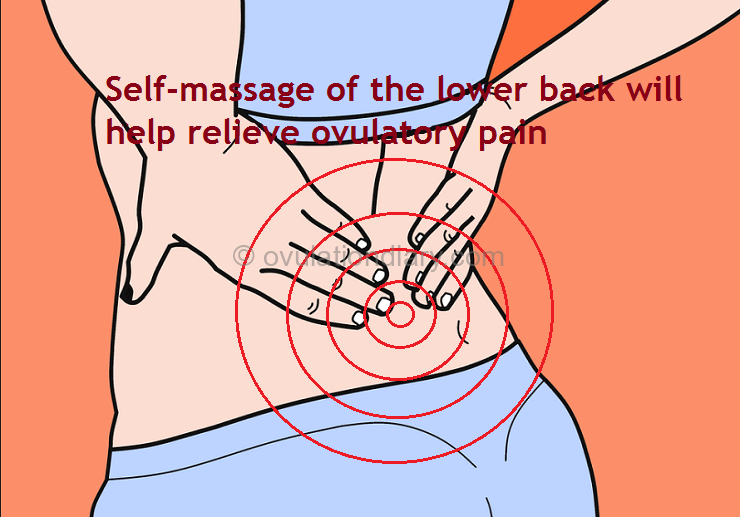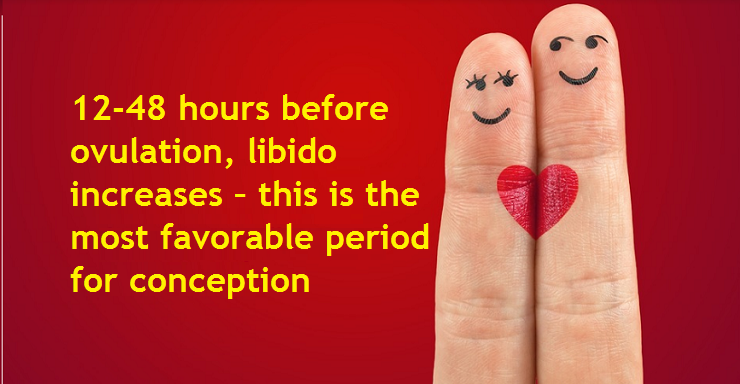
The onset of ovulation is often accompanied by such symptoms:
- bleeding;
- change in the nature of cervical mucus;
- drawing pains, tingling or discomfort in the lower abdomen, ovaries, or lower back (sometimes the pain radiates to the rectum);
- soreness, increased sensitivity of the nipples and chest fullness;
- nausea;
- the amount of blackheads and acne increases;
- increased sexual drive;
- bloating.
Discharge of egg white consistency and spotting during ovulation
Vaginal discharge of raw egg white consistency is a clear signal of imminent ovulation (within a day or two).
Sometimes during a follicle rupture a small blood vessel bursts, resulting in a little bleeding, but not more than a few drops and no longer than for a day. The definitions of ovulation by cervical mucus are described in detail in the article on discharge during ovulation).
Pain in the abdomen and ovaries as the first sign of ovulation that you can feel
Pain in the ovaries, uterus and lower back – are most often felt during ovulation. Self-massage, relaxation and a peaceful bath will help to reduce soreness.

Another reason is if the released fluid, after follicle rupture, presses on the nerve endings thereby causing their irritation. Read more about ovulatory pain in painful ovulation.
Sore and sensitive breasts
After ovulation, progesterone begins to be produced intensively. Consequently:
- Fluid retention in the tissues;
- Skin is stretched, and the breast itself is roughened;
- The pressure on the nerve endings and blood vessels increases, therefore the chest hurts during ovulation and after it.
Those symptoms, characteristic of some women, can indicate whether ovulation has passed. The feeling of fullness and sensitivity accompanies almost the entire second phase of the cycle until the menstrual period.
What should alert you?
- sharp chest pain;
- discharge (normal during lactation period or the next three years after it);
- lumps, knots or hardening in breast tissue (especially if there is no pain);
- fever and redness in this place (possibly combined with severe headache, for example during mastitis).

![]() Attention(!): When experiencing sharp chest pain, discharge, lumps, redness, change in shape, you must visit a doctor.
Attention(!): When experiencing sharp chest pain, discharge, lumps, redness, change in shape, you must visit a doctor.
Nausea during ovulation
There are several possible reasons.
- First: increased production of prostaglandins, which causes vascular spasms and smooth muscles spasms – hence nausea during ovulation.
- Second: hormonal fluctuations, sharp increase in testosterone levels (results in increased libido). Or increase in estrogen before ovulation which leads to fluid retention in the body.
- Third: physiological causes – scars, sutures in the pelvis, on the uterus, ovaries, or tubes. At the time of ovulation, the pelvic organs are intensively supplied with blood, resulting in their enlargement, consequently pressuring receptors of the abdominal cavity, causing nausea.
However, nausea itself cannot be considered as a separate symptom after ovulation, but only in combination with other symptoms. Moreover, nausea would certainly be a recurring part of your cycle (at least periodically).
![]() From experience(!): I, for example, often feel slight nausea on ovulation day, regardless of what I ate that day. Mine is caused by the first reason. I was even more sick during both births, also slight nausea occurs from time to time after intimacy (after experiencing an orgasm). All these symptoms, in my case, are associated with the active production of prostaglandins.
From experience(!): I, for example, often feel slight nausea on ovulation day, regardless of what I ate that day. Mine is caused by the first reason. I was even more sick during both births, also slight nausea occurs from time to time after intimacy (after experiencing an orgasm). All these symptoms, in my case, are associated with the active production of prostaglandins.
Why do blackheads and acne appear on the day of ovulation and after it
When the ovary is releasing a mature egg, some women experience an increased level of androgens (male sex hormones). In addition to the hormone fluctuations, the production of sebum increases. Moreover, its density and viscosity change. This leads to pores blockage and the inflammatory process in them. So blackheads and acne occur. Over time, the level of androgens decreases and the skin clears in 4-5 days.
Sexual desire and Ovulation
The desire for intimacy is a very common sensation during ovulation. Most often, libido gets stronger 2-3 days before ovulation, with an increase in estrogen levels. During this period, the consistency of cervical mucus changes and the woman feels constant moisture, resulting in sexual desire.
![]() Note(!): If there is more cervical fluid and it has acquired the structure of crude protein, as well as an increase in sexual desire – this almost certainly would indicate the approaching ovulation. This is the most favorable period for a successful conception. It’s time for intimacy.
Note(!): If there is more cervical fluid and it has acquired the structure of crude protein, as well as an increase in sexual desire – this almost certainly would indicate the approaching ovulation. This is the most favorable period for a successful conception. It’s time for intimacy.

Bloating during ovulation
Increased gas formation during the ovulation period, occurs due to fluid retention in the body, as a result of estrogen level fluctuations. If you cannot determine the obvious nutritional causes of bloating and flatulence (appears and disappears suddenly after a day or two) and it is recurring every cycle – this is another symptom of ovulation.
Is there ovulation without symptoms?
It certainly happens. In this case, other methods must be used to track fertility. First, you would need to find out the duration of the second phase (from ovulation to menstruation) – the same woman has a stable duration of the second phase. How to find out the length of the second phase? It begins immediately after ovulation. The day when the ovary is releasing a mature egg is determined using these methods. It could be one at a time or several.
![]() For example(!): If the length of the second phase is 13 days, then you need to subtract 13 days from the cycle duration and get the O (predicted ovulation date). If the cycle is 31 days, 31-13 = 18. Ovulation occurs on day 18.
For example(!): If the length of the second phase is 13 days, then you need to subtract 13 days from the cycle duration and get the O (predicted ovulation date). If the cycle is 31 days, 31-13 = 18. Ovulation occurs on day 18.
There is a separate chapter on the chances of getting pregnant in the days before and after ovulation.
Using the calendar method, we can determine ovulation date in case of a regular cycle. But, when the cycle is unstable, we could determine ovulation using other methods. Knowing the length of the luteal (second) phase and the ovulation date, you can determine the day X – the beginning of menstruation: O+2F, where O is the ovulation date, and 2F is the length of the second phase.
If menstruation did not start on the expected day, this is definitely a delay and you could do pregnancy testing.
